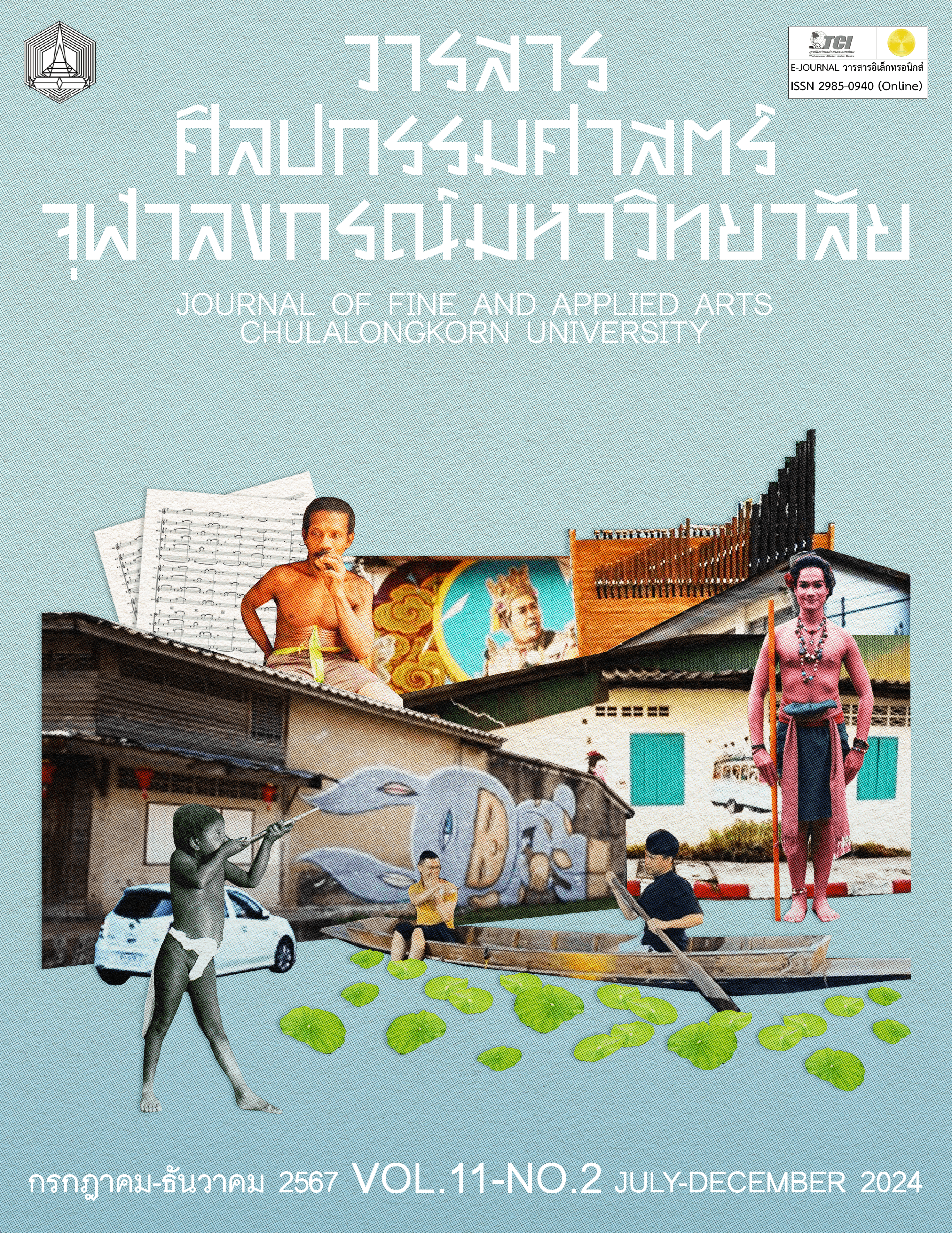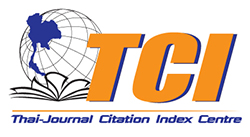SERI’S ACCENT, SUPHAN ACCENT
Keywords:
Lukthung, Central Thai’s Folk Songs, Suphanburi’s Accent, Lukthung Singing, Seri RungsawangAbstract
In this article, I examine and analyze the singing style of Seri Rungsawang, an established figure in lukthung music who has won several awards and has a large fanbase. Seri's singing style is interesting because it is based on phleng phuen ban, a traditional half-singing, half-recitation genre, combined with the heavy influence of lukthung style accumulated through Seri's 44-year experience in the industry. This study focuses on Seri's singing techniques in the song "Plew Fai Thi Plai Thian" (The Candle's Flame), which premiered in 2021 under a collaboration with Singto Khamram Records. The song won the Khom Chad Luek Award for the best lukthung song and the Amazing Suphanburi Award in 2022. Ethnographic methods were used to collect and interpret field data. The findings reveal that Seri is self-taught and has been a hardworking singer for the most part of his career. His singing process begins with studying the song's melody and closely reading its lyrics, which leads to him imagining a specific mood and tone upon which the singing is predicated. 1) Seri described his singing in his own terminology as follows: 1.1) sculpting of words (kan pan kham), 1.2) vocal articulation, 1.3) rhythmic variation of the voice, 1.4) distributing the lyrics against the assigned beats (kan chat chaung fai), 1.5) shortening of words (kan khamuat kham), 1.6) shaken words (siang khluen krasao), 1.7) engorging words (khayauk kham), 1.8) singing to kick the rhythm (raung te changwa), 1.9) singing behind the beat (raung lang changwa), and 1.10) cheating the wind (kan lak lom). 2) Seri's singing approach includes 2.1) controlled vocal articulation, 2.2) comprehending lyrics, and 2.3) creating lyrical melody, while projecting the sung words in a Suphanburi accent. This study illustrates a set of singing techniques and approaches that allow a lukthung singer to thrive in the fast-changing industry while retaining the genre's traditional singing practices. Seri's musical experience demonstrates one of many variants of the lukthung musical genre from central Thailand that is worthy of preserving and passing on to aspiring singers of the next generation.
References
Adank, Patti, Bronwen G. Evans, Jane Stuart-Smith, and Sophie K. Scott. “Comprehension of familiar and unfamiliar native accents under adverse listening conditions.” Journal of Experimental Psychology: Human Perception and Performance 35, no. 2 (April 2009): 520-529. https://doi.org/10.1037/a0013552.
Bourdieu, Pierre. “The Forms of Capital.” In Handbook of Theory and Research for the Sociology of Education, Edited by John G. Richardson, 241-258. New York: Greenwood, 1986.
Chanwirot, Sirirat. “The Charm of Thai Locals: Which Accent is ‘Accented?’.” http://ica.swu.ac.th/news/detail/2/153.
ศิริรัตน์ จันทร์วิโรจน์. “เสน่ห์ท้องถิ่นไทย สำเนียงไหนเรียกว่า ‘เหน่อ’.” http://ica.swu.ac.th/news/detail/2/153.
Charoensin-o-larn, Chairat. Development Discourse: Power of Knowledge, Character of Truth, and Otherness. 6th edition. Bangkok: vibhasa, 2017.
ไชยรัตน์ เจริญสินโอฬาร. วาทกรรมการพัฒนา : อำนาจ ความรู้ ความจริง เอกลักษณ์ และความเป็นอื่น. พิมพ์ครั้งที่ 6. กรุงเทพฯ : วิภาษา, 2560.
Kanboon, Phisut. “A Study of Seri Rungsawang’s Singing Methodology.” Master Thesis, Srinakharinwirot University, 2008.
พิสุทธิ์ การบุญ. “ศึกษาวิธีการขับร้องของ เสรี รุ่งสว่าง.” วิทยานิพนธ์ระดับปริญญามหาบัณฑิต, มหาวิทยาลัยศรีนครินทรวิโรฒ, 2551.
Kraisame, Sarawut. “Phonetics and Phonology, Language and Speech Technology.” Interview by Nantida Chandransu. April 18, 2023.
สราวุฒิ ไกรเสม. “สัทศาสตร์และสัทวิทยา, เทคโนโลยีภาษาและเสียง.” สัมภาษณ์โดย นันธิดา จันทรางศุ. 18 เมษายน 2566.
Latham, Alison. The Oxford Companion to Music. Oxford: Oxford University Press, 2023. https://www.oxfordmusiconline.com
Prasittikun, Thuam. The Main Book of the Art of Singing. Bangkok: n.p., 1986.
ท้วม ประสิทธิกุล. หลักคีตศิลป์. กรุงเทพฯ : ม.ป.พ., 2529.
Royal Institute. Royal Institute Dictionary, BE 2554 (2011), Bangkok: Nanmeebooks Publication, 2013.
ราชบัณฑิตยสถาน. พจนานุกรมฉบับราชบัณฑิตยสถาน พ.ศ. 2554. กรุงเทพฯ : นานมีบุ๊คส์พับลิเคชั่นส์, 2556.
Rungsawang, Seri. “Seri's singing techniques in the song.” Interview by Duangduan Longsawas. February 22, 2023.
เสรี รุ่งสว่าง. “เทคนิคการขับร้องของเสรี.” สัมภาษณ์โดย ดวงเดือน หลงสวาสดิ์. 22 กุมภาพันธ์ 2566.
Rungsawang, Seri. “Singing style of Seri Rungsawang.” Interview by Nantida Chandransu. July 12, 2022.
เสรี รุ่งสว่าง. “สไตล์การขับร้องของเสรี รุ่งสว่าง.” สัมภาษณ์โดย นันธิดา จันทรางศุ. 12 กรกฎาคม 2565.
Rungsawang, Seri. “Singing style of Seri Rungsawang.” Interview by Duangduan Longsawas. February 19, 2023.
เสรี รุ่งสว่าง. “สไตล์การขับร้องของเสรี รุ่งสว่าง.” สัมภาษณ์โดย ดวงเดือน หลงสวาสดิ์. 19 กุมภาพันธ์ 2566.
Rungsawang, Seri. “Suphanburi’s Accent.” Interview by Danai Noichuen. March 7, 2023.
เสรี รุ่งสว่าง. “สำเนียงสุพรรณบุรี.” สัมภาษณ์โดย ดนัย น้อยชื่น. 7 มีนาคม 2566.
Srikammul, Samran. The English Phonics. Phra Nakhon Si Ayutthaya: Mahamakut Buddhist University Mahavajiralongkorn Rajavidyalaya Campus, 2022.
สำราญ ศรีคำมูล. สัทศาสตร์ภาษาอังกฤษ. พระนครศรีอยุธยา : มหาวิทยาลัยมหามกุฏราชวิทยาลัย วิทยาเขตมหาวชิราลงกรณราชวิทยาลัย, 2565.
Sujachaya, Sukanya. Traditional Folk Songs Studies. 2nd edition. Bangkok: Chulalongkorn University Press, 2022.
สุกัญญา สุจฉายา. เพลงพื้นบ้านศึกษา. พิมพ์ครั้งที่ 2. กรุงเทพฯ : สำนักพิมพ์จุฬาลงกรณ์มหาวิทยาลัย, 2545.
Suraratdecha, Sumittra. “Social Linguistics.” Interview by Nantida Chandransu. April 14, 2023.
สุมิตรา สุรรัตน์เดชา. “ภาษาศาสตร์สังคม.” สัมภาษณ์โดย นันธิดา จันทรางศุ. 14 เมษายน 2566.
Thai Junior Encyclopedia Foundation by His Majesty King Bhumibol Adulyadej The Great. The Thai Junior Encyclopedia, No. 33. Bangkok: Thai Junior Encyclopedia Foundation, 2008.
มูลนิธิโครงการสารานุกรมไทยสำหรับเยาวชน โดยพระราชประสงค์ในพระบาทสมเด็จพระบรมชนกาธิเบศร มหาภูมิพลอดุลยเดชมหาราช บรมนาถบพิตร. สารานุกรมไทยสำหรับเยาวชนฯ, เล่มที่ 33. กรุงเทพฯ : มูลนิธิโครงการสารานุกรมไทยสำหรับเยาวชนฯ, 2551.
Thai Junior Encyclopedia Foundation by His Majesty King Bhumibol Adulyadej The Great. The Thai Junior Encyclopedia, No. 34. Bangkok: Thai Junior Encyclopedia Foundation, 2009.
มูลนิธิโครงการสารานุกรมไทยสำหรับเยาวชน โดยพระราชประสงค์ในพระบาทสมเด็จพระบรมชนกาธิเบศร มหาภูมิพลอดุลยเดชมหาราช บรมนาถบพิตร. สารานุกรมไทยสำหรับเยาวชนฯ, เล่มที่ 34. กรุงเทพฯ : มูลนิธิโครงการสารานุกรมไทยสำหรับเยาวชนฯ, 2552.
Wongthes, Sujit. “Where Does Lukthung Come from? When Jamnong Rangsikun Coined ‘Phleng Lukthung’ by Thai TV Channel 4 Bangkhunphrom in 1964.” https://www.matichonweekly.com/column/article_130305.
สุจิตต์ วงษ์เทศ. “เพลงลูกทุ่ง มาจากไหน? ‘จำนง รังสิกุล’ เมื่อ 2507 ผู้สร้างสรรค์ชื่อ ‘เพลงลูกทุ่ง’ ไทยทีวีช่อง 4 บางขุนพรหม.” https://www.matichonweekly.com/column/article_130305.
Wongthes, Sujit. “Where Does Suphanburi’s Accent Come from?.” https://www.silpa-mag.com/culture/article_14777.
สุจิตต์ วงษ์เทศ. “สำเนียง ‘เหน่อ’ ของสุพรรณ ที่เรียกว่า ‘เหน่อสุพรรณ’ มาจากไหน?.” https://www.silpa-mag.com/culture/article_14777.
Downloads
Published
Issue
Section
License
Copyright (c) 2024 นันธิดา จันทรางศุ, ดนัย น้อยชื่น, ดวงเดือน หลงสวาสดิ์

This work is licensed under a Creative Commons Attribution-NonCommercial-NoDerivatives 4.0 International License.
ลิขสิทธิ์ของบทความเป็นของเจ้าของบทความ บทความที่ได้รับการตีพิมพ์ถือเป็นทัศนะของผู้เขียน
กองบรรณาธิการไม่จำเป็นต้องเห็นด้วยและไม่รับผิดชอบต่อบทความนั้น






